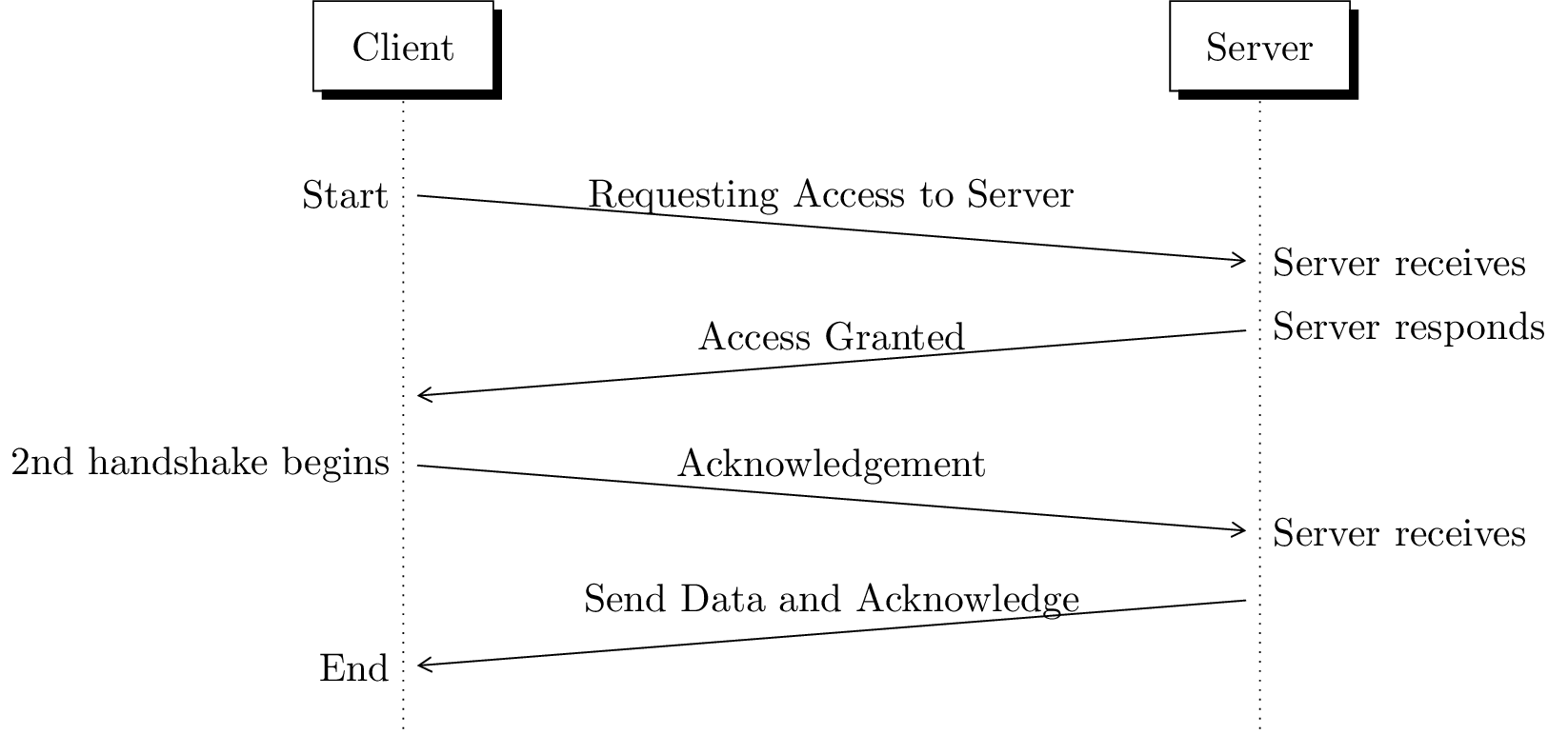Description
The code is a LaTeX document that creates a sequence diagram using the pgf-umlsd package. The diagram shows a simple example of client-server messaging with two threads: a client and a server. The document begins with the definition of a new command "bloodymess" that draws arrows between the client and server and specifies their direction and content. The sequence diagram is then created using the "sequencediagram" environment, and two instances "c" and "s" are defined for the client and server, respectively. Four "bloodymess" commands are used to show the flow of communication between the client and server. The first message shows the client requesting access to the server, the second message shows the server granting access, the third message shows the client acknowledging the access, and the final message shows the server sending data to the client and acknowledging the receipt. The diagram is labeled with start and end notes. The output is a PDF image of the sequence diagram.
Keywords
latex, diagram, float, tikz, positioning, fit, calc, shapes, arrows, pgf-umlsd, sequencediagram, newinst, bloodymess, inst, Requesting Access to Server, Access Granted, Acknowledgement, 2nd handshake begins, Send Data and Acknowledge.
Source Code

\documentclass[ border={60pt 0pt 55pt 0pt}
% left bottom right top] real order is left bottom right top
]{standalone}
\usepackage{float}
\usepackage{tikz}
\usetikzlibrary{positioning, fit, calc, shapes, arrows}
\usepackage[underline=false]{pgf-umlsd}
% message between threads
% Example:
% \bloodymess[delay]{sender}{message content}{receiver}{DIR}{start note}{end note}
\newcommand{\bloodymess}[7][0]{
\stepcounter{seqlevel}
\path
(#2)+(0,-\theseqlevel*\unitfactor-0.7*\unitfactor) node (mess from) {};
\addtocounter{seqlevel}{#1}
\path
(#4)+(0,-\theseqlevel*\unitfactor-0.7*\unitfactor) node (mess to) {};
\draw[->,>=angle 60] (mess from) -- (mess to) node[midway, above]
{#3};
\if R#5
\node (#3 from) at (mess from) {\llap{#6~}};
\node (#3 to) at (mess to) {\rlap{~#7}};
\else\if L#5
\node (#3 from) at (mess from) {\rlap{~#6}};
\node (#3 to) at (mess to) {\llap{#7~}};
\else
\node (#3 from) at (mess from) {#6};
\node (#3 to) at (mess to) {#7};
\fi
\fi
}
\begin{document}
%\begin{figure}[H]
% \centering
\begin{sequencediagram}
\newinst{c}{Client}
\newinst[6]{s}{Server}
\bloodymess[1]{c}{Requesting Access to Server}{s}{R}{Start}{Server receives}
\bloodymess[1]{s}{Access Granted}{c}{L}{Server responds}{}
\bloodymess[1]{c}{Acknowledgement}{s}{R}{2nd handshake begins}{Server receives}
\bloodymess[1]{s}{Send Data and Acknowledge}{c}{L}{}{End}
\end{sequencediagram}
%\caption{Client-Server messaging example}
%\end{figure}
\end{document}